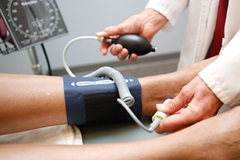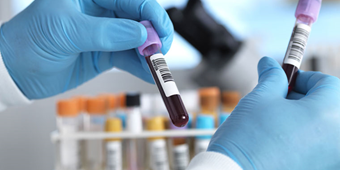- Cardiology And Vascular Health
- Diabetes
- Health Topics
- Stroke And Other Vascular Diseases
- Vascular Health
Don't Let PAD Leg Pain Get You Down

Answer a few questions and we'll provide you with a list of primary care providers that best fit your needs.
Leg pain, cramping, and/or fatigue that occurs while you walk or climb stairs - and stops when you stop - could be cause for concern. This is one of the symptoms of a condition called peripheral artery disease or PAD.
PAD affects blood vessels outside of the heart, most commonly in the legs. It is usually caused by a buildup of fat or cholesterol in the arteries, narrows the blood vessels, and reduces or even blocks blood flow.
Your leg muscles depend on oxygen-rich blood, so when the arteries narrow and the blood flow is reduced, it causes pain. The most common symptoms are:
- Difficulty walking
- Pain in the hips, thighs, or calves
- Leg tightness, cramping, or pain similar to a charley horse
Other symptoms that could signal PAD in the legs, feet, and/or toes include:
- Coldness (usually on one side)
- Open sores and poor wound healing
- Weak or absent pulse
- Change in skin color (usually bluish)
- Hair loss or slowed hair growth
Who’s At Risk For PAD?
Developing PAD is part of the aging process once you reach your 70s. Other conditions that put you at risk for PAD include diabetes, high blood pressure, high cholesterol, and smoking.
Don’t Let PAD Slow You Down
Gary J. Fishbein, MD, says that many people who experience PAD-associated leg pain begin walking less. That’s the wrong approach, he says. “You start living your life in a box. And inactivity leads to worsening high blood pressure, worsening cholesterol, worsening diabetes. It’s a never-ending cycle.”
 How Is PAD Diagnosed?
How Is PAD Diagnosed?
PAD is caused by atherosclerosis, the buildup of plaque on artery walls, and can be diagnosed in a variety of ways, starting with a doctor reviewing your symptoms and health history. To confirm PAD diagnosis and determine the location and severity of blockages, your doctor may prescribe any of a variety of non- and minimally invasive tests:
- Ankle-brachial index. This test compares blood pressure in the ankle and arm to determine if blood flow is restricted in your limbs.
- Doppler ultrasound. This uses sound waves to create an image of blood flow in your major leg arteries.
- Magnetic resonance angiogram. This creates an image of blood flow in your legs, using magnetic and radio waves.
- Arteriogram. This uses a contrast dye visible on an X-ray to determine where blood flow is restricted.
These tests may need to be followed by a more invasive test to determine the exact location of blockages.
Dr. Gary Fishbein discusses diagnosis and treatment of peripheral arterial disease (PAD).
Click play to watch the video or read video transcript.
How Is PAD Treated?
When diagnosed in early stages - before atherosclerosis and arterial blockages become advanced - PAD can often be controlled and reversed through medication and lifestyle changes, such as:
- Quitting smoking
- Eating a heart healthy diet
- Participating in a supervised exercise (walking) program
More advanced arterial blockage associated with PAD may require surgical procedures such as:
- Bypass grafting. This involves grafting a blood vessel from another part of your body - or a synthetic vessel - above and below a blockage. This allows blood to flow around the blocked artery.
- Angioplasty and stenting. A surgeon threads a thin tube (catheter) with a balloon through the clogged artery. When inflated, the balloon widens the arterial opening by flattening plaque against the artery walls. In some cases, a metal mesh (stent), which may contain clot-preventing medication, is inserted to reinforce the opening.
- Atherectomy. This involves threading a thin tube (catheter) through the artery, cutting through or dissolving the blockage.
- Endarterectomy with Ocelot. This is an advanced, minimally invasive procedure to open the blocked artery. Cardiologists and vascular surgeons use a laser fiber to image the artery wall, allowing the device to drill through plaque in the artery with reduced risk of damaging the artery wall. The Ocelot increases the likelihood of success with fewer complications.
Dr. Fishbein explains how Ocelot is used in the treatment of peripheral artery disease.
Click play to watch the video or read video transcript.
To learn more about peripheral artery disease, talk to your doctor or health care provider or search for a provider.
Answer a few questions and we'll provide you with a list of primary care providers that best fit your needs.
Source: Gary Fishbein, MD, Dayton Heart Center







